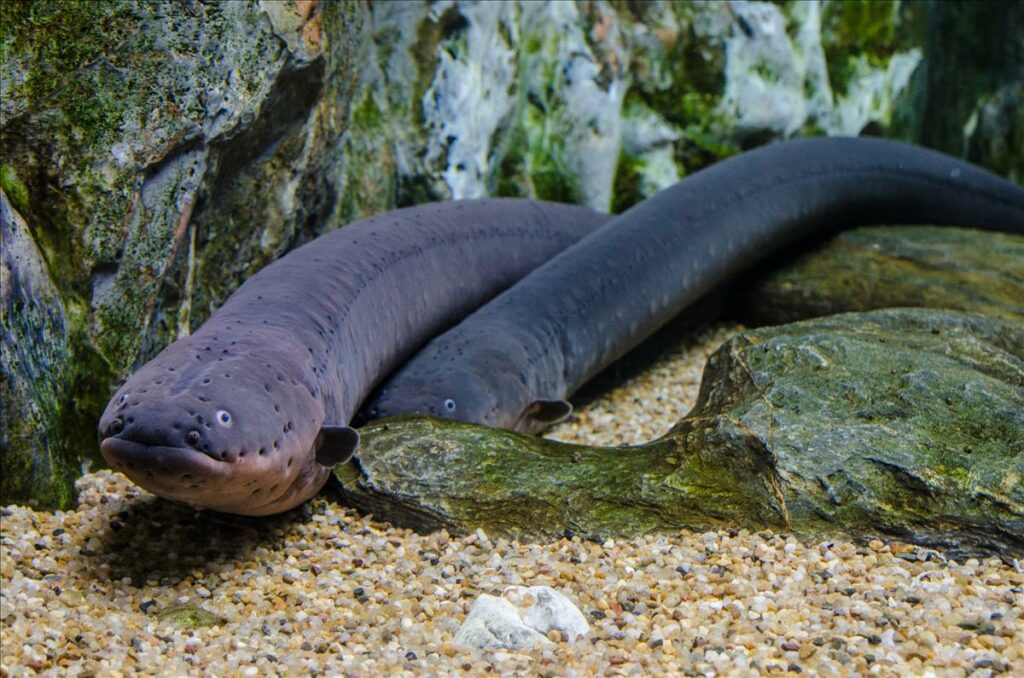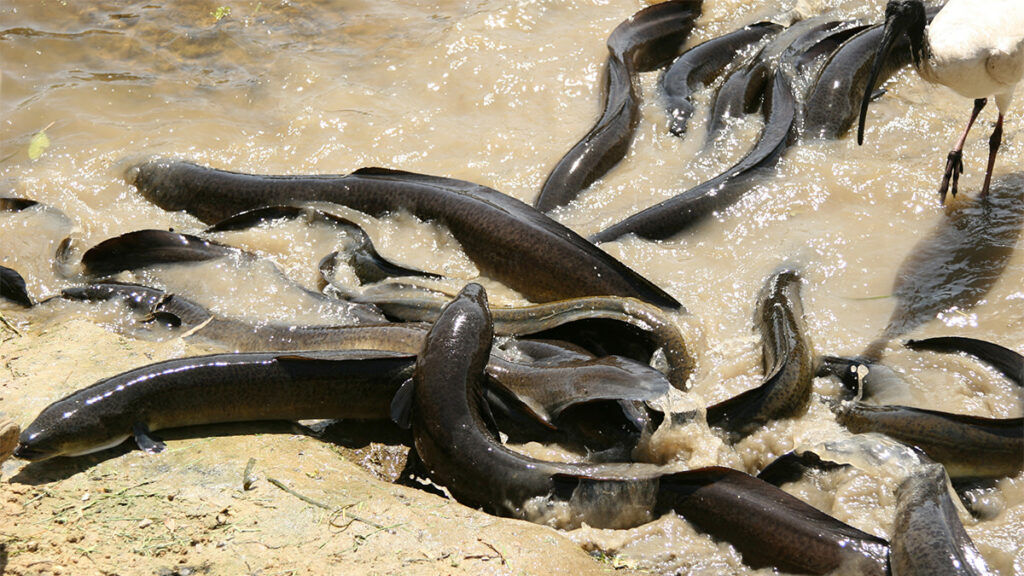For the longest time, eel reproduction was a mystery. It hasn’t been until recently that researchers began to understand the process.

What Are Eels?
All ‘true’ eel species have a few characteristics in common:
- Has a continuous dorsal fin that connects with the caudal and anal fins
- Small, embedded scales or no scales
- They spend part of their lives in freshwater and part in saltwater
- They produce slime
- They have many sharp teeth
- Juvenile eels are flat and look like a ribbon
Also, despite the fact that they look like snakes, eels are a type of fish.
How Do Eels Reproduce?
Researchers have been studying eels for centuries. Despite this, eel reproduction remained a mystery until recently. Even today, much is still unknown about the reproduction process.
To understand eel reproduction, we first need to ask, where do eels reproduce?
Freshwater Eels Travel Far To Spawn
Researchers have long known where eels live. Yet, no one had seen them mate or even travel to their spawning grounds.
Then, a few years ago, Canadian researchers began tracking American eels. They attached GPS trackers to 38 American eels, successfully monitoring 28 of them. But, they could only track one eel for the entire migration.
That single eel led researchers 1,500 miles (2,400 km) across the ocean to the Sargasso Sea. It accomplished this tremendous feat in just 45 days.
Freshwater eels are catadromous. This means that they live most of their adult lives in freshwater. But, they are born, spawn, and die in saltwater.
All freshwater European and American eels reproduce in the Sargasso Sea. The Sargasso Sea expands across Bermuda, the Azores, and the West Indies. It is a two-million-square-mile expanse of ocean.
Japanese and giant mottled eels travel elsewhere to spawn. Researchers Katsumi Tsukamoto et. al. say that those eels spawn in the North Pacific.
“We found that the spawning site of this species appears to be near three seamounts in the West Mariana Ridge, 2000–3000km away from their freshwater habitats. These seamounts are located in the westward flow of the North Equatorial Current and are hypothesized to provide cues for migrating silver eels and to serve as possible aggregation sites for spawning.”
Saltwater Eel Reproduction
Freshwater eel reproduction is like saltwater eel reproduction. But, much is unknown about the saltwater eel’s reproductive practices.
The moray eel, for instance, produces eggs and fertilizes them in the same way that freshwater eels do. But, their larvae don’t travel across the ocean like freshwater larvae. Moray eel larvae settle at the bottom of the ocean to hide. They travel deeper as they age.
The Eel Reproductive System
The eel reproductive system also remains mostly a mystery. Researchers haven’t been able to locate reproductive organs in juvenile eels. So, they are unsure when eels begin to develop them.
But, researchers have seen gonads in eels drawing close to their adult stage. Most of the juvenile eels that had developed gonads were about 11 in (26 cm) long.
How Do Eels Mate?

If you see eels mating, it’s like a giant, blackish-brown squirming cloud. Hundreds to thousands of eels will mate at the same time. Doing so increases the chances that the eggs become fertilized.
Researchers believe that eels mate through external fertilization. The females release millions of eggs into the surrounding water. At the same time, the males release their sperm. The eggs that come into contact with the sperm become fertilized.
An Eel’s Life Cycle
Once the eggs are laid, they float to the surface to hatch. The emerging larvae are “leptocephali”. They are tiny, transparent, and shaped like a leaf.
Leptocephali won’t stay in the spawning grounds forever. Instead, they begin the long one to five-year journey to their freshwater habitat.
Glass Eels
Eventually, the larvae reach the entrance of their freshwater habitat. At this age, they’ll have grown to about 2-3 in (5-7.6 cm) in length. Their bodies are still transparent at this stage, so they are referred to as “glass” eels.
Besides their see-through bodies, they look like fully-developed eels. Their bodies will have become long and slender, and they will have developed their fins.
As a glass eel, their goal is to find a suitable habitat to spend the rest of their lives in. It’s not always as easy as just finding the mouth of a river. Sometimes, glass eels must travel between ponds and lakes before they reach a river. They are able to slither small distances across the land to “hop” between bodies of water.
Elver Eels
As they get closer to their river habitat, their body continues to transform. They enter the “elver” stage where their bodies grow to about 4 in (10 cm) long. Their bodies also change from transparent to gray, brown, or black. At the elver stage, juvenile eels look like adult eels, only smaller.
Yellow Eels
Once they reach their destination, they will have become “yellow” eels. At this stage, eels are still considered juveniles. Eels will not become sexually mature adults until they are ready to spawn and die. So, juveniles spend about 20 years as yellow eels.
Silver Eels
Once a freshwater eel becomes sexually mature, it is called a “silver” eel.
Male eels reach sexual maturity at about 15.7 in (40 cm) in length. Females grow much larger, sometimes reaching lengths up to 47.2 in (120 cm).
Once eels hit sexual maturity, their only goal is to reproduce, and they will do so by any means necessary.
Silver eels begin their journey between late winter and spring. They travel from the river, back to the ocean. Often, the journey to the spawning grounds is thousands of miles/kilometers.
An eel’s stomach degenerates and they don’t eat for the entire journey. The blood vessels around the bladder increase to offer more support. Even their eyes double in size so that they can see better in the dark.
Once they reach their destination, the eels will spawn. Having completed their life mission, they will then die.
Conclusion
Much remains unknown about eel reproduction, but researchers have made tremendous progress.
Freshwater eels live most of their lives as juvenile yellow eels. Once they become adults, silver eels prepare to spawn and die. It’s unusual that freshwater eels spawn in the ocean when the rest of their lives are spent in freshwater. But, it’s something that all freshwater eels have in common.
FAQs
Considering eel reproduction is such a complex process, do eels reproduce in captivity?
For the longest time, researchers had no idea how eels reproduce. Eel reproduction is a new discovery, and is still not completely understood.
Yet, eel populations are dwindling due to human activity. Overfishing, habitat destruction, and water pollution are all problems.
It’s necessary for us to breed eels in captivity to save their numbers, but it’s not an easy task.
For the first time in 2010, two generations of captive eels were bred. This accomplishment goes to researchers at Shibushi laboratory in Japan.
According to Yale University “Japanese fish farmers have been managing the middle part of the eel life cycle since the late 1800s.” But, breeding eels from birth to death is something that is new.
The difficulty is getting them through periods where they’re most likely to die or experience major changes. Researchers refer to these periods as “bottlenecks”.
To get eels to mature sexually, researchers must simulate a set of environmental cues. These cues include salinity, light, and temperature. They also stimulate them with hormones.
There is little research on eunuch eels, but the term simply refers to eels that are sterile.
Eels are meant to reach sexual maturity, travel to their spawning grounds, and then die. But, some theorize that eunuch eels stay in freshwater, continuing to live and get bigger.
It’s likely that sterile, long-lived eels will grow larger. Still, it’s unlikely that they will grow to monstrous sizes.
Much like true eels, researchers are unsure how electric eels reproduce. Some believe that eels lay batches of eggs throughout the breeding season. Others believe they lay a single, large batch of eggs.
In any case, female electric eels lay between 1,200-1,700 eggs in a single season. Reproduction occurs during the dry season.
The male’s job is to construct a nest for the eggs made of saliva. Once the female produces the eggs, it is the male’s duty to guard them. They will continue to guard the larvae until the rainy season begins.
Juvenile electric eels develop their electrical organs shortly after birth. Studies show that eels as small as 0.59 in (15 mm) begin developing electrical organs. Still, the organs do not fully develop until the eel is about 1.57 in (40 mm) long.
Eel eggs are produced by the thousands. Releasing thousands of eggs at once increases successful fertilization. Still, in the end, only a fraction of those eggs actually hatch.
